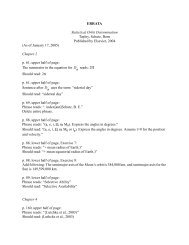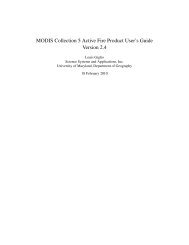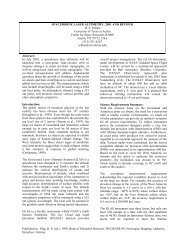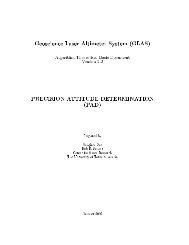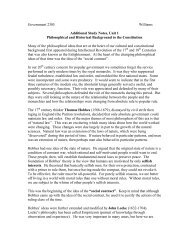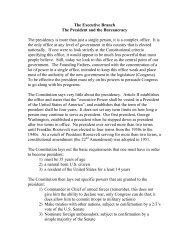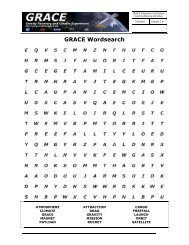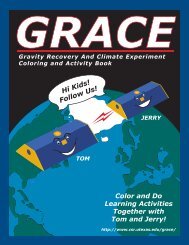Exploiting Class Hierarchies for Knowledge Transfer ... - IEEE Xplore
Exploiting Class Hierarchies for Knowledge Transfer ... - IEEE Xplore
Exploiting Class Hierarchies for Knowledge Transfer ... - IEEE Xplore
You also want an ePaper? Increase the reach of your titles
YUMPU automatically turns print PDFs into web optimized ePapers that Google loves.
RAJAN et al.: EXPLOITING CLASS HIERARCHIES FOR KNOWLEDGE TRANSFER IN HYPERSPECTRAL DATA 3409make use of expectation maximization (EM) have met with aconsiderable success in a number of domains, especially thatof text data analysis and remote sensing. These algorithmsattempt to maximize the joint log-likelihood of both the labeledand the unlabeled data by iteratively reestimating theconditional distribution of a hidden variable, indicating the trueclass associated with the unlabeled data. It is important to notethat the standard <strong>for</strong>mulation <strong>for</strong> semisupervised classificationtechniques assumes that both the labeled and unlabeled datahave a common underlying distribution. This assumption isviolated <strong>for</strong> the application scenario considered in this paper,since it is likely that the statistics of the unlabeled data differsomewhat from that of the previously acquired labeled data, i.e.,there is a population drift [8].<strong>Class</strong>ification in the presence of population drift: Severalattempts at dealing with the problem of changing populationshave borrowed ideas from the field of online learning or incrementallearning. Most online algorithms are designed asfeedback systems. It is assumed that there is a steady streamof objects to be classified, the true labels of which are revealedimmediately after classification. Prior knowledge about the typeof the population drift (random/gradual/sudden) is then usedto update the existing classifier at regular intervals [8], [9].The online algorithms attempt to minimize the cumulativenumber of errors made, such that the resulting classifier doesnot per<strong>for</strong>m much worse than a classifier trained on the samedata in batch mode. A detailed review of several online-learningalgorithms is provided in [10].Adapting online methods to deal with the problem of populationdrift typically involves maintaining a window of theincoming training samples. At appropriate intervals, the set ofhypotheses is either retrained, or some of the outdated hypothesesare removed and replaced with those that are more consistentwith the recently seen observations [9]. While remotelysensed data obtained over extensive regions (or different times)also exhibit the problem of “population drift,” unlike the onlineframeworks, one does not have access to a streaming set oflabeled data samples.<strong>Knowledge</strong> transfer and reuse: The vast majority ofworks in machine learning and data mining focuses on solvinga specific classification task, which is isolated from other tasks.However, in practice, one is often faced by a series of (possiblyrelated) tasks, or a task whose nature changes substantially withtime. Existing techniques require large quantities of labeleddata to be able to deal effectively with the changes in aclassification task. The question then is, can one transfer theknowledge in a previously learned classifier to better tacklethe latest classification task, instead of totally reinitiating theanalysis, as is usually done?In the mid-1990s, a first generation of approaches that involvedexplicit knowledge transfer/reuse emerged, under labelssuch as “knowledge transfer,” “learning to learn,” context sensitivity/drift,and “lifelong learning” [11]–[13]. For instance,several researchers attempted to directly reuse the internal statein<strong>for</strong>mation from classifiers under the belief that related classificationtasks may benefit from common internal features. Someof the other approaches of knowledge reuse include the useof supplemental training examples or historical training in<strong>for</strong>mation,such as learning rates, reusing the labels produced byoriginal classifiers to improve the generalization per<strong>for</strong>manceon a new classifier <strong>for</strong> a different but related task, and multitasklearning neural networks that are trained simultaneously toper<strong>for</strong>m several related classification tasks.B. Semisupervised Learning and <strong>Knowledge</strong> <strong>Transfer</strong> <strong>for</strong>Remote Sensing ApplicationsThe advantages of using unlabeled data to aid the classificationprocess in the domain of remote sensing data was firstidentified and exploited by Shahshahani and Landgrebe [1].In this work, they made use of the unlabeled data via EMto obtain better estimates of class-specific parameters. It wasshown that using unlabeled data enhanced the per<strong>for</strong>manceof the maximum a posteriori probability (MAP) classifiers,especially when the dimensionality of the data approached thenumber of training samples. Subsequent extensions to the EMapproach include using “semilabeled” data in the EM iterations[14], [15]. In these methods, the available labeled data are firstused to train a supervised classifier to obtain tentative labels<strong>for</strong> the unlabeled data. Semilabeled data, thus obtained, arethen used to retrain the existing classifier, and the process isiterated until convergence. Note that these methods assume thatthe labeled and the unlabeled data are drawn from the samedistribution. In other words, the estimated class parametersare considered unreliable because of the nonavailability of thelabeled data and not because of changes in the underlying datadistribution.Besides the typical semisupervised setting, unlabeled datahave also been utilized <strong>for</strong> “partially supervised classification”[16], [17]. In partially supervised classification problems, thetraining samples are provided only <strong>for</strong> a specific class of interest,and the classifier must determine whether the unlabeleddata belong to the class of interest. While Mantero et al. [17]attempt to model the distribution of the class of interest andautomatically determine a suitable “acceptance probability,”Jeon and Landgrebe [16] make use of the unlabeled data whilelearning a maximum-likelihood (ML) classifier to determinewhether a data point is of interest or not.While all these methods deal with the data obtained from thesame image, the possibility that the class label of a pixel couldchange with time was first explored in [18]. In this work, thejoint probabilities of all possible combinations of classes betweenthe multitemporal images were estimated and used in theclassification rule. The proposed “multitemporal cascade classifier,”however requires the labeled data from all the imagesof interest. More recently, unsupervised algorithms, which canautomatically detect whether a particular pixel in multitemporalimages has changed have also been proposed [19]. Besidesalgorithms <strong>for</strong> change detection, supervised algorithms whichautomatically try to model the class transitions in multitemporalimages have also been developed [20]. Another supervisedattempt at classifying multitemporal images involves building alocal classifier <strong>for</strong> each image, the decisions of which are thencombined, either via a joint likelihood-based rule or a weightedmajority decision rule that takes into account the reliabilitiesof the data sets and that of the individual classes, to yield a“global” decision rule <strong>for</strong> the unlabeled data [21]. Similarly,other spatial-temporal methods utilize the temporal correlationof the classes between images to help improve the classificationaccuracy [22], [23].



